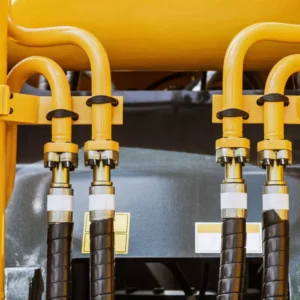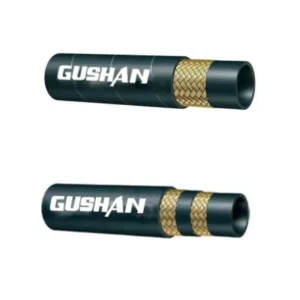Accurately measuring a hydraulic hose is crucial for ensuring proper replacement and optimal system performance. Whether you’re a DIY enthusiast or a professional technician, understanding the correct measurement techniques is essential.
In this guide, we’ll walk you through the step-by-step process of measuring a hydraulic hose, providing valuable tips and considerations.
Hydraulic Hose Length Formula
Unfortunately, there isn’t a single, universal formula to calculate the exact length of a hydraulic hose. This is because many factors influence the final hydraulic hose length, such as the hydraulic hose routing, the number and type of fittings, and the amount of flex or bend radius in the hose.
However, you can estimate the required hose length by following these steps:
- Measure the straight-line distance: This is the shortest distance between the two connection points.
- Account for bends and curves: Add additional length for each bend or curve. The amount of additional length depends on the radius of the bend.
- Consider fitting lengths: Add the length of the fittings on both ends of the hose.
- Allow for extra length: It’s always a good practice to add some extra length to account for potential routing changes or future modifications.
While there isn’t a specific formula, many hydraulic hose manufacturers and suppliers offer tools and calculators to assist in estimating hose length. These tools often consider factors like hose type, bend radius, and fitting configurations.
It’s highly recommended to consult with our hydraulic hose specialist or engineer to accurately determine the required hose length for your specific application. We can provide expert advice and help you select the right hose and fittings.
How to Measure Hydraulic Hose
Here we make a video telling you about how are hydraulic hoses measured above.
Here are the step-by-step guide telling you how to measure a hydraulic hose in the following:
Tools Needed
To accurately measure hydraulic hoses, you’ll need the following tools:
1. Vernier Caliper:
- This tool is used to measure the inside diameter (ID) and outside diameter (OD) of the hose.
- It provides precise measurements, essential for selecting the correct replacement hose.
2. Measuring Tape:
- A flexible measuring tape is used to measure the overall length of the hose, including any bends or curves.
- Ensure the tape measure is accurate and easy to read.
3. Hose Identification Chart:
- This chart provides information on different hose types, sizes, and pressure ratings.
- It can help you identify the specific type of hose you need to replace.
Step 1: Identify the Hydraulic Hose Type
- Consult the Manufacturer’s Manual: Refer to the original equipment manufacturer‘s (OEM) manual for specific hose specifications.
- Visual Inspection: Examine the hose for any markings or labels that indicate its size, material, and pressure rating.
- Check for Wear and Tear: Look for signs of damage, such as cracks, cuts, or excessive wear, which may affect the accuracy of your measurements.
Step 2: Measure the Inside Diameter (ID)
How to Measure Hydraulic Hose Diameter?
1. Measuring the Inside Diameter (ID):
Use a Caliper:
- Insert the caliper’s jaws into the hose’s opening, ensuring they are fully seated.
- Take multiple measurements at different points along the hose to account for any variations in diameter.
- Record the average measurement as the inside diameter.
2. Measuring the Outside Diameter (OD):
- Use the same caliper method as for the ID.
- Simply measure the outer diameter of the hose.
Tips for Accurate Measurement:
- Clean the Hose: Remove any dirt, grease, or debris that may interfere with the measurements.
- Use a Reliable Measuring Tool: Ensure your caliper is calibrated and accurate.
- Double-Check Measurements: Take multiple measurements to verify accuracy.
By following these steps and using the right tools, you can accurately measure the diameter of your hydraulic hose.
Step 3: Measure the Overall Length
How to measure hydraulic hose length? Here is a brief guide about Hydraulic Hose Length Measurement.
Straight Hoses: Use a measuring tape to measure the distance between the two end fittings. Ensure the tape measure is taut to avoid inaccuracies.
Curved Hoses:
- String Method: Wrap a string around the curved portion of the hose, mark the endpoints, and then measure the string’s length.
- Flexible Measuring Tape: Use a flexible measuring tape to follow the curve of the hose.
Step 4: Note Additional Details
- Fitting Types: Identify the type of fittings on the hose (e.g., SAE, metric, JIC) to ensure compatibility with replacement hoses.
- Hose Material: Determine the material of the hose (e.g., rubber, thermoplastic) to select the appropriate replacement hose.
- Pressure Rating: Note the maximum pressure rating of the hose to ensure it can handle the required operating pressure.
- Temperature Range: Consider the temperature range the hose is designed to withstand to select a suitable replacement.
Tips for Accurate Hydraulic Hose Measurement:
- Clean the Hose: Remove any dirt, grease, or debris that may interfere with the measurements.
- Use a Reliable Measuring Tool: Ensure your measuring tools are calibrated and accurate.
- Double-Check Measurements: Take multiple measurements to verify accuracy.
- Consult a Specialist: If you’re unsure about any aspect of the measurement process, consult a hydraulic specialist.
By following these steps and considering the additional tips, you can accurately measure your hydraulic hose and select the correct replacement.
Hydraulic Hose Length Calculator
In today’s fast-paced manufacturing environment, precision and efficiency are paramount. As a leading hydraulic hose manufacturer, we understand the importance of accurate production and inventory management. That’s why we’ve implemented an automatic hydraulic hose length calculator to streamline our operations and ensure optimal output.
How Our Calculator Works:
- Real-time Data: Our calculator continuously collects data from our production lines, including the start and stop times of each hose production run.
- Accurate Length Measurement: By analyzing the production speed and duration of each run, we can precisely calculate the length of hydraulic hose produced.
- Inventory Management: The calculated lengths are automatically integrated into our inventory system, providing real-time updates on stock levels.
- Quality Control: The calculator also helps us monitor production quality by identifying any deviations from standard length specifications.
Benefits of Our Automatic Hydraulic Hose Length Calculator:
- Improved Accuracy: Reduces errors in length measurement, ensuring precise production.
- Enhanced Efficiency: Streamlines production processes and minimizes downtime.
- Optimized Inventory: Accurate inventory data prevents stockouts and overstocking.
- Enhanced Quality Control: Identifies potential quality issues early on.
- Cost Savings: Reduces waste and minimizes production costs.
By leveraging advanced technology, we’re committed to delivering high-quality hydraulic hoses and exceptional customer service. Contact us today to learn more about our products and services.
Conclusion
Accurately measuring hydraulic hoses is crucial for ensuring proper fit and function. By following the steps outlined in this guide, you can measure your hoses effectively. Remember to prioritize safety, use the right tools, and double-check your measurements.
Need high-quality hydraulic hoses cut to your exact specifications?
Gushan Rubber offers precision cutting services to ensure you get the perfect length for your application. Our team of experts can accurately measure and cut your hoses to minimize waste and maximize efficiency.
Contact us today to learn more about our custom-cutting services.



